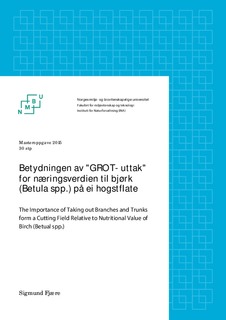| dc.description.abstract | Uttaket av heltrehogst (GROT) til bioenergiformål forventes å øke i Norge i tiden framover. GROT-uttak gir økt biomasseuttak og dermed større næringsuttak fra skogen. Mengden karbon og nitrogen i jordbunnen reduseres etter GROT-uttak, samt at gjenvekstens biomasse reduseres. Næringsverdien til et plantemateriale bestemmes mye av forholdet mellom karbon og nitrogen, samt konsentrasjonen av sekundære metabolitter. Planteforsvarshypotesene søker å forklare hvordan planten avveier mellom plantevekst og produksjon av sekundære metabolitter. I denne oppgaven har jeg undersøkt betydningen av heltrehogst vs konvensjonell hogst på konsentrasjonen av fenoler og mengden av nitrogen og karbon i gjenveksten av bjørk (Betula spp.) ved å samle inn lauv fra to hogstflater på Voss og Gaupen. Høstprøvene fra Voss viste effekt av behandling, der GROT-uttak førte til mindre nitrogen i lauvprøvene, mens GROT-uttak førte til mer karbon i vår- sommerprøvene fra Voss. Mangel på utslag på Gaupen kan skyldes forskjellige vekstvilkår i forhold til Voss, eller det lengere tidspunktet fra hogst til innsamling i forhold til Voss. Jeg fant negative utslag av GROT-uttak på konsentrasjonen av klorogensyrer og MeOH-uløselige kondenserte tanniner, mens apigeniner viste positive utslag. Voss viste høyere innhold av klorogensyrer enn Gaupen, mens forholdet var motsatt for flavonoider, trolig påvirket av et høyere beitetrykk på Gaupen enn på Voss, som gir høyere produksjon av mer kompliserte og spesialiserte forbindelser som flavonoider. Sesongmønsteret viste en økning for tanninene utover i sesongen, mens mange av flavonoidene gikk motsatt vei, som bare delvis er i tråd med PCM-hypotesen. Resultatene viser at konsekvensene av heltrehogst for næringsverdien i gjenveksten av bjørk ikke må undervurderes.
The rate of whole tree harvesting (hereafter named GROT) for bioenergy purposes in Norway is more than likely going to grow in the times coming. GROT- withdrawn increases the biomass withdrawn from the forest, and as a consequence there is being removed more of the nutrient from the forest. The amount of carbon and nitrogen in the soil or ground is reduced, and the regrew of the biomass is reduced. A plant's nutritive value is based mainly on the relationship between carbon and nitrogen, and also the concentration of secondary metabolites. The many plant-defense-hypotheses tries to explain how the plant may choose between growth and production of secondary metabolites. In this master thesis I have studied the impact of GROT- withdrawn versus traditional stam cutting and tried to see any differences based on the concentration of phenolic, and also the amount of the remaining nitrogen and carbon in the regrown birch (Betula spp.). I have collected leaves from trees on two separate clear-cut fields, Voss and Gaupen. The samples collected in the autumn, from Voss, was showing a effect of GROT. The tests showed less nitrogen compared to samples from conventional harvest. However, the samples from GROT collected in the spring and summer, turned out to consist of a higher concentration of carbon. There were negative test results from GROT-fields versus traditional stam cutting from Voss when testing for concentration of cholorgenic acids and MeOH-unsoluble condensed tannins, but apigenins showed positive. The lack of significant result from Gaupen may caused by the time-frame from the tree felling to the samples was taken who differ between the places, and different conditions of soil. Voss showed a higher concentration of chologenic acids than Gaupen results, but the oposite was true for flavonoids. I suspect the result is a effect of a higher rate of grazing in Gaupen. Grazing does produce a higher level of more complicate and spesial compounds like flavanoids. When comparing the results up against the seasons, the tannins was increasing throughout the season, while many of the flavanoids decreased. This is not fully in line with the PCM-hypothesis. My findings show that the concequenses of GROT- withdrawn relative to the nutrition value of regrown birch must not be overlooked. | nb_NO |
